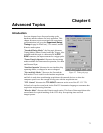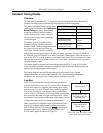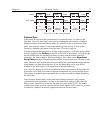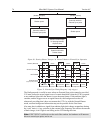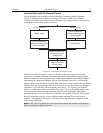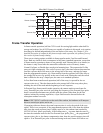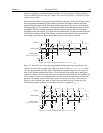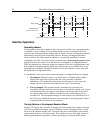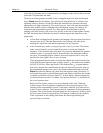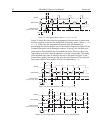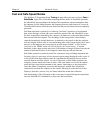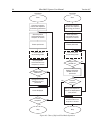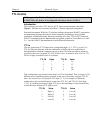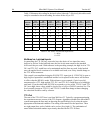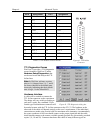
80 MicroMAX System User Manual Version 6.C
External Sync
(negative polarity shown)
NOT SCAN
Shutter
t
w1
t
c
t
exp
cleans
acquisition
t
R
t
R
t
R
t
R
actual exposure time
Figure 36. Frame Transfer where Pulse arrives after Readout
Interline Operation
Operating Modes
It is important to note that an interline chip can operate in either of two operating modes,
overlapped or non-overlapped. The operating mode is always overlapped unless the
exposure time is shorter than the readout time, in which case non-overlapped operation is
automatically selected by the controlling software. Because overlapped operation is
faster, to achieve the fastest possible operation, it is generally preferable to operate
overlapped if possible. Thus there may be situations where increasing the exposure time
slightly will cause the camera to switch from non-overlapped to overlapped operation.
When this happens, the video may blank for a moment as the unit is reprogrammed, and
then reappear with approximately double the frame rate that was available when it was
operating non-overlapped. Detailed discussions of how the interline camera works and
the implications for operation follow.
As stated before, there are two basic operating m
odes, overlapped and non-overlapped:
• Overlapped: When the cam
era is operated in the overlapped mode, readout
begins at the end of the exposure time and a new exposure is initiated
immediately. This mode allows the fastest possible speed. And, because the
charge only has to transfer to the adjacent row, there is no smearing.
• Non-overlapped: This operation m
ode is automatically selected by the
controlling software when the exposure time is less than the readout time. In non-
overlapped operation, the image is transferred to the storage cells at the end of
the exposure time and no further accumulation occurs (the imaging cells are
switched off). The accumulated charge on each storage cell is transferred out of
the CCD array, amplified, and sent to the controller as an analog signal, where it
is digitized prior to transfer to the computer.
Timing Options in Overlapped Readout Mode
Interline CCD arrays have columns of imaging cells alternating with columns of storage
cells. During readout, the charge stored in the photo-sensitive imaging cells move only
one row to the adjacent storage cells. From there they move downwards to the readout
register and from there to the output node. This scheme serves to allow high speeds, no
smearing and shutterless operation, a distinct advantage over frame-transfer sensors




